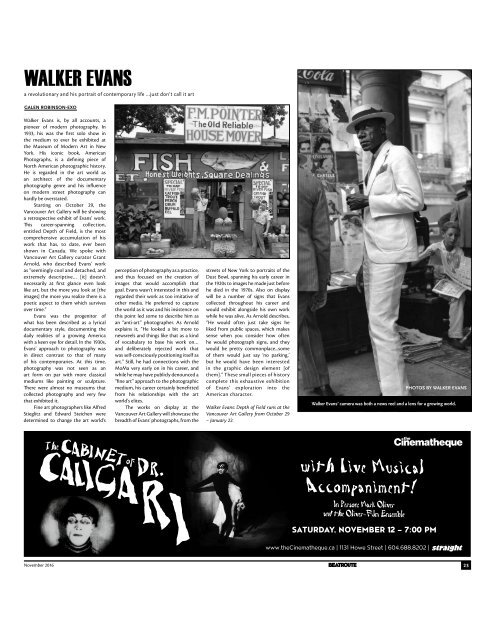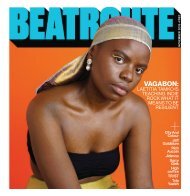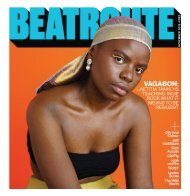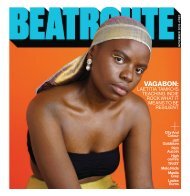BeatRoute Magazine B.C. print e-edition - November 2016
BeatRoute Magazine is a monthly arts and entertainment paper with a predominant focus on music – local, independent or otherwise. The paper started in June 2004 and continues to provide a healthy dose of perversity while exercising rock ‘n’ roll ethics.
BeatRoute Magazine is a monthly arts and entertainment paper with a predominant focus on music – local, independent or otherwise. The paper started in June 2004 and continues to provide a healthy dose of perversity while exercising rock ‘n’ roll ethics.
You also want an ePaper? Increase the reach of your titles
YUMPU automatically turns print PDFs into web optimized ePapers that Google loves.
WalkeR evanS<br />
a revolutionary and his portrait of contemporary life ...just don’t call it art<br />
GALEN ROBINSON-EXO<br />
Walker Evans is, by all accounts, a<br />
pioneer of modern photography. In<br />
1933, his was the first solo show in<br />
the medium to ever be exhibited at<br />
the Museum of Modern Art in New<br />
York. His iconic book, American<br />
Photographs, is a defining piece of<br />
North American photographic history.<br />
He is regarded in the art world as<br />
an architect of the documentary<br />
photography genre and his influence<br />
on modern street photography can<br />
hardly be overstated.<br />
Starting on October 29, the<br />
Vancouver Art Gallery will be showing<br />
a retrospective exhibit of Evans’ work.<br />
This career-spanning collection,<br />
entitled Depth of Field, is the most<br />
comprehensive accumulation of his<br />
work that has, to date, ever been<br />
shown in Canada. We spoke with<br />
Vancouver Art Gallery curator Grant<br />
Arnold, who described Evans’ work<br />
as “seemingly cool and detached, and<br />
extremely descriptive… [it] doesn’t<br />
necessarily at first glance even look<br />
like art, but the more you look at [the<br />
images] the more you realize there is a<br />
poetic aspect to them which survives<br />
over time.”<br />
Evans was the progenitor of<br />
what has been described as a lyrical<br />
documentary style, documenting the<br />
daily realities of a growing America<br />
with a keen eye for detail. In the 1930s,<br />
Evans’ approach to photography was<br />
in direct contrast to that of many<br />
of his contemporaries. At this time,<br />
photography was not seen as an<br />
art form on par with more classical<br />
mediums like painting or sculpture.<br />
There were almost no museums that<br />
collected photography and very few<br />
that exhibited it.<br />
Fine art photographers like Alfred<br />
Stieglitz and Edward Steichen were<br />
determined to change the art world’s<br />
perception of photography as a practice,<br />
and thus focused on the creation of<br />
images that would accomplish that<br />
goal. Evans wasn’t interested in this and<br />
regarded their work as too imitative of<br />
other media. He preferred to capture<br />
the world as it was and his insistence on<br />
this point led some to describe him as<br />
an “anti-art” photographer. As Arnold<br />
explains it, “He looked a bit more to<br />
newsreels and things like that as a kind<br />
of vocabulary to base his work on…<br />
and deliberately rejected work that<br />
was self-consciously positioning itself as<br />
art.” Still, he had connections with the<br />
MoMa very early on in his career, and<br />
while he may have publicly denounced a<br />
“fine art” approach to the photographic<br />
medium, his career certainly benefitted<br />
from his relationships with the art<br />
world’s elites.<br />
The works on display at the<br />
Vancouver Art Gallery will showcase the<br />
breadth of Evans’ photographs, from the<br />
streets of New York to portraits of the<br />
Dust Bowl, spanning his early career in<br />
the 1920s to images he made just before<br />
he died in the 1970s. Also on display<br />
will be a number of signs that Evans<br />
collected throughout his career and<br />
would exhibit alongside his own work<br />
while he was alive. As Arnold describes,<br />
“He would often just take signs he<br />
liked from public spaces, which makes<br />
sense when you consider how often<br />
he would photograph signs, and they<br />
would be pretty commonplace...some<br />
of them would just say ‘no parking,’<br />
but he would have been interested<br />
in the graphic design element [of<br />
them].” These small pieces of history<br />
complete this exhaustive exhibition<br />
of Evans’ exploration into the<br />
American character.<br />
Walker Evans: Depth of Field runs at the<br />
Vancouver Art Gallery from October 29<br />
– January 22.<br />
PHOTOS BY WALKER EVANS<br />
Walker Evans’ camera was both a news reel and a lens for a growing world.<br />
<strong>November</strong> <strong>2016</strong> 23


















